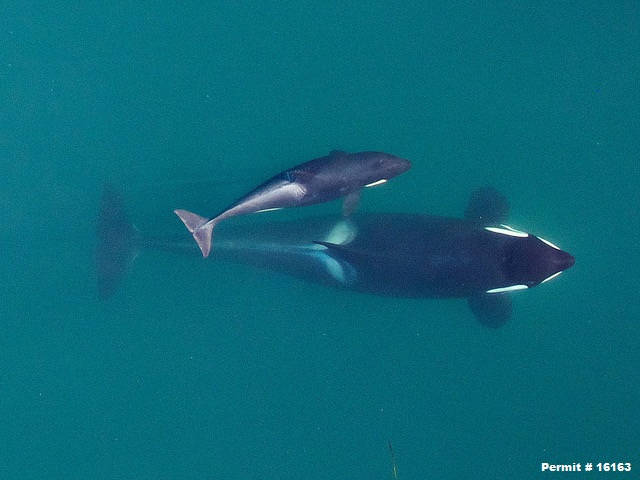Federal agencies are working together to save a young orca, J50, and have been monitoring orca mother, J35, who after 17 days and approximately 1,000 miles, let go of her deceased calf.
According to officials, that duration of time is unprecedented behavior for orcas.
Rescue efforts for a nearly 4-year-old Southern resident orca, J50, who is described as severely emaciated with a possible infection near her blowhole, are now underway by the National Oceanic Atmospheric Administration officials and Fisheries and Oceans Canada with assistance from the Lummi Nation.
“A strong sense of urgency developed [in early August] after photos came back showing her deteriorating body condition,” said Lynne Barre, NOAA Southern resident orca recovery coordinator.
On Aug. 11, as J pod headed south toward Cape Flattery on the tip of the Olympic Peninsula the team was able to administer antibiotics via a dart to J50. According to veterinarian Marty Haulena, there was a slight bounce after hitting her body, which meant only half the dose actually went into her system.
NOAA has been monitoring the body conditions of both the Southern and Northern resident orcas to get a better picture of the whales’ overall health. Comparing the two groups could give clues as to why the Southern residents are struggling. The Southern resident killer whales are comprised of three pods, or groups they live in, which are J, K and L.
Listed as endangered in 2005, the Southern resident population has continued to decline. J, K and L pods now total 75 whales, the lowest number in approximately 30 years. The biggest issue, researchers believe, is the lack of Chinook salmon, their primary food source.
It was through this in-depth study, using drones and photographic technology, that officials were able to determine the extent of J50’s deterioration.
Barre said that since the time of her birth, J50 has been a unique orca, with a tendency to travel farther away from her mother than other young orcas, even frequently swimming a distance away from her pod.
“She has always been small for her age,” she added.
In addition to the photographs, some researchers reported that her breath had a foul order, Barre said. After a week of discussions and guided by veterinarians, NOAA submitted legal permits for a rescue plan and were granted a green light to proceed, according to Teri Rowles, veterinarian and NOAA Marine Mammal Health and Stranding program coordinator.
The project includes some unprecedented methods – although they stem from procedures used on sick and injured seals and sea lions and techniques that rehabilitated a Northern resident orca calf separated from her pod 16 years ago.
The first step was to gain a complete health analysis of J50. This includes both breath and fecal samples. This will confirm if J50 suffers from an infection, starvation or some other illness. Due to the sore near her blowhole, an infection is strongly suspected.
On Aug. 9, not only was the team able to get a breath sample, Haulena said they were also able to administer an antibiotic Convenia via dart, which should last 7-10 days. While it only took one try to administer, the process did not go quite as smoothly as he had hoped.
According to Brad Hanson, NOAA biologist, J pod was active along the west side of San Juan Island, Aug. 11 and 12. J50 struggled against the heavy currents, he said and appeared tired at times. The team was able to collect a fecal sample from a family member. It is now being analyzed to see if DNA belongs to J50 and if so what it reveals about her health.
On Sunday, Aug. 12, with assistance from the Lummi Nation, the team deployed live Chinook in front of J50. They positioned the boat 50 to 100 meters ahead of her and the rescue team released a handful of fish.
With cameras, videos and drones, they monitored how both the young orca and her pod reacted. Releasing salmon in front of orcas has never been done before. J50 did not appear to react or change course toward the fish. None of the orcas in J pod were observed eating the fish.
Hanson said it was difficult to tell if she even detected them. The latest sighting on Monday, Aug. 13 had J pod heading west, so currently, the team is on standby.
While Haulena describes being shocked at seeing her body condition for the first time, he remains hopeful.
“She is a very skinny little whale,” he said.
Despite that, J50 appears to be keeping up with her pod well, socializing, moving from one subgroup to another, Haulena said. She took several deep dives and seemed to be breathing well.
For more information, visit http://www.westcoast.fisheries.noaa.gov/protected_species/marine_mammals/killer_whale/updates-j50-j35.html.



